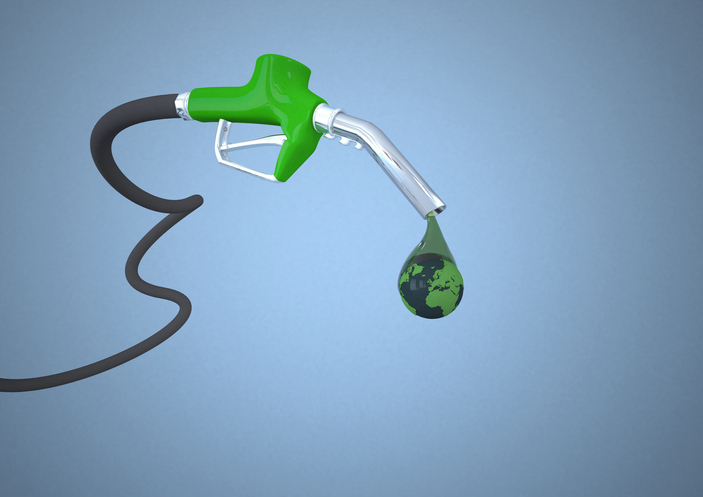How Sustainable Fuel Flows Through Existing Infrastructure

Success comes with responsibility, so commercial transportation and logistics potential could pale in comparison to the obligation of these areas in helping reduce the world’s carbon footprint.
According to the U.S. Environmental Protection Agency (EPA), the transportation sector produces nearly 29 percent of the country’s greenhouse gas (GHG) emissions. To successfully decarbonize will take nothing short of a Herculean effort, among individual companies and collectively, in public and private sectors.
Determining which technologies, equipment, training and investments equate to the wisest environmental approach will undoubtedly include the consideration of sustainable fuels and electric vehicles (EV), involving unknown costs and time-tested patience.
The New Pump and Go Ecosystem
The potential issues arising from fossil fuel use and subsequent chemical waste emissions have long been discussed.
Twenty years ago, the waste and flare from oil and gas production facilities worldwide — and their excess carried into the atmosphere — was of particular interest to California oil and gas company Greyrock. “At the time,” says Liz Myers, vice president business development at Infinium, “Greyrock’s company founders developed a solution to leverage those emissions and strained assets to create cleaner burning fuels.”
The new product helped mitigate emissions compared to the alternatives available back then, she says. “But about 10 years ago, the company started R&D into carbon dioxide (CO₂) conversion for the same reasons,” she adds. Instead of accepting the waste inherent in fossil fuel, it chose to harness CO₂ and turn it from a liability into a valuable product — clean burning fuel. Through this new technology, Infinium was born.
The Sacramento, California-based electrofuel technology company provides maritime, transportation and aviation sectors a viable sustainable alternative to fossil fuels. These commercial industries face multilayered challenges in seeking decarbonization through battery, electric and hydrogen use.
Although policy support is driving the change, Infinium is also experiencing customer support for the platform. Collectively, the acceptance and demand for decarbonization is escalating, Myers says.
Existing Infrastructure Is a Game Changer
A redeeming factor of the Infinium electrofuels (e-fuels) platform is that it works with a company’s current infrastructure, allowing existing fleets to seamlessly move from fossil fuel use. This “drop-in” solution enables decarbonization, adds Myers, without changes to the vehicles or how the fuel is transported to them.
Industry analysis on fossil fuel and the integration of electric or hydrogen conversion for the global aviation industry indicates a US$3 trillion to $6 trillion impact.
With Infinium’s business rooted in the longevity of Greyrock, the company can quickly scale and deploy gas-to-liquid commercial applications. Assessing the benefits of a fleet’s fuel conversion begins from the point the Infinium e-fuels are delivered. “We engage a detailed life cycle analysis of the fuel, measuring its carbon intensity throughout to the end customer,” Myers says, providing accurate GHG emissions reporting and documentation of a lower carbon footprint.
Versatility Speaks Volumes and Value
Migrating from fossil fuel-based operations to biofuel technology involves preparation, launch and execution — and managing disruption. The longer it takes to deploy such a program, the greater the potential increase in production and operational downtime.
Another key differentiator rests in how the fuel is formulated and its intrinsic value to the environment. “It’s a reformulation that looks like fossil-based fuel with near net zero carbon impact. By recapturing the CO₂ that would otherwise be emitted, added to renewable power-derived hydrogen, sustainable jet-diesel and other products are created,” she says.
During combustion, these synthetic sulfur-free e-fuels release lower particulate matter and less contaminants compared to fossil-based fuel. Myers states that Infinium’s diesel e-fuel has a higher level of cetane, improving ignition quality providing added benefit to the engine and fuel, ideal for maritime and agricultural applications.
Fuel Options
Successful sustainability integration and execution requires research and an understanding of individual business needs, growth goals and available spend. Just as important, ensuring flexibility within the plan provides the room for necessary pivots when regulatory and operational shifts occur.
To assure business decisions better align with environmental, social and governance (ESG) policies, companies must know the options and barriers to realize sustainability goals.
EV-based transportation and logistics fleets are coming to the fore, but the timeline for enterprise-wide execution is often hampered by costs and an existing commercial infrastructure that does not support the emerging technologies.
Biofuels provide renewable energy sources by converting biomass directly into liquid fuels. The most common types of biofuels in use today are ethanol and biodiesel, providing some reduction in carbonization output. Blended with 80 percent petroleum diesel, “B20” is the most common biodiesel.
But the heavy imprint of fossil-based fuel that remains in B20 and other biofuels is at the crux of why transportation and logistics industries continue to seek other options that offer more decarbonization value, as well as time and cost efficiencies.
Decarbonization, One Hub at a Time
Growing a carbon-zero economy involves cooperation from public and private sectors. According to Myers, getting more alternative fuels into the market helps meet global decarbonization goals. “We still have a long way to go before e-fuels trump fossil-based fuels,” she says.
Infinium’s business model includes “clean fuel hubs” located in areas already producing ample CO₂ emissions and low-cost renewable energy. In the U.S. and Europe, the company is developing hydrogen hubs that aggregate and leverage existing infrastructure, common in industrial centers and port cities.
“As demand continues to grow, these are the areas that provide opportunity, building out volume and sustainability incrementally,” Myers says.


